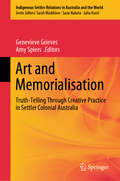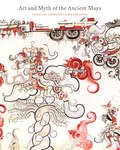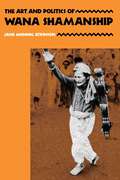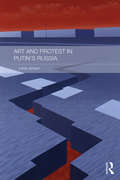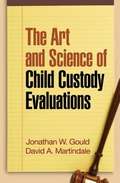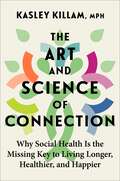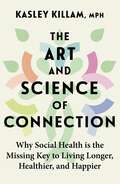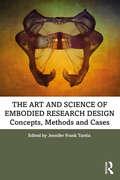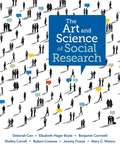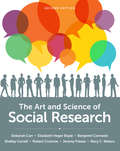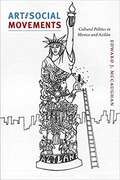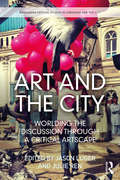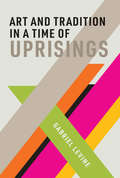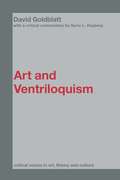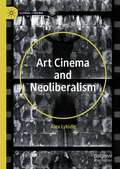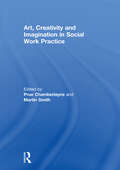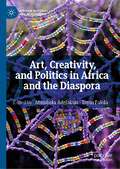- Table View
- List View
Art and Memorialisation: Truth-Telling Through Creative Practice in Settler Colonial Australia (Indigenous-Settler Relations in Australia and the World #6)
by Genevieve Grieves Amy SpiersThis edited volume reflects on the profound effort undertaken by artists to contest settler denial and amnesia to disclose Australia's foundations in racialised violence and land theft. The book examines how First Nations creative and cultural practitioners have turned to the unique spaces of art and culture to remember and mourn the profound loss of life caused by British invasion and colonisation in the absence of official commemoration and public acknowledgement of the damage caused. It significantly focuses on a number of creative practitioners driving this powerful memory-work, containing contributions from some of the leading thinkers on truth-telling through creative practice, including Fiona Foley, Dianne Jones, Vicki Couzens, Julie Gough, r e a, Tony Birch, Paola Balla, Neika Lehman, Arlie Alizzi, Charmaine Papertalk Green, Kate Golding, Odette Kelada and Clare Land. An important contribution to scholarship on the public memorialisation of difficult histories, this significant edited collection foregrounds First Nations, female, queer, trans and gender diverse artists and scholars from the continent that is known as 'Australia'. Taken together these deeply researched, considered texts, poems and conversations lend vital, critical perspectives on the ways artists are confronting settler colonial Australia’s toxic colonial memorial culture of denial. This book recognises that through a range of creative means and mediums, artists and cultural practitioners are making essential contributions to truth-telling, devising evocative, sensitive ways to make the injustices committed against First Peoples not only visible and tangible, but also strongly felt and grieved.
Art and Myth of the Ancient Maya
by Oswaldo Chinchilla MazariegosThis nuanced account explores Maya mythology through the lens of art, text, and culture. It offers an important reexamination of the mid-16th-century Popol Vuh, long considered an authoritative text, which is better understood as one among many crucial sources for the interpretation of ancient Maya art and myth. Using materials gathered across Mesoamerica, Oswaldo Chinchilla Mazariegos bridges the gap between written texts and artistic representations, identifying key mythical subjects and uncovering their variations in narratives and visual depictions. Central characters—including a secluded young goddess, a malevolent grandmother, a dead father, and the young gods who became the sun and the moon—are identified in pottery, sculpture, mural painting, and hieroglyphic inscriptions. Highlighting such previously overlooked topics as sexuality and generational struggles, this beautifully illustrated book paves the way for a new understanding of Maya myths and their lavish expression in ancient art.
The Art and Politics of Wana Shamanship
by Jane Monnig AtkinsonRituals are valued by students of culture as lenses for bringing facets of social life and meaning into focus. Jane Monnig Atkinson's carefully crafted study offers unique insight into the rich shamanic ritual tradition of the Wana, an upland population of Sulawesi, Indonesia.
Art and Protest in Putin's Russia (Routledge Contemporary Russia and Eastern Europe Series)
by Lena JonsonThe Pussy Riot protest, and the subsequent heavy handed treatment of the protestors, grabbed the headlines, but this was not an isolated instance of art being noticeably critical of the regime. As this book, based on extensive original research, shows, there has been gradually emerging over recent decades a significant counter-culture in the art world which satirises and ridicules the regime and the values it represents, at the same time putting forward, through art, alternative values. The book traces the development of art and protest in recent decades, discusses how art of this kind engages in political and social protest, and provides many illustrations as examples of art as protest. The book concludes by discussing how important art has been in facilitating new social values and in prompting political protests.
Art and Risk in Ancient Yoruba
by Suzanne Preston BlierIn this book, Suzanne Preston Blier examines the intersection of art, risk and creativity in early African arts from the Yoruba center of Ife and the striking ways that ancient Ife artworks inform society, politics, history and religion. Yoruba art offers a unique lens into one of Africa's most important and least understood early civilizations, one whose historic arts have long been of interest to local residents and Westerners alike because of their tour-de-force visual power and technical complexity. Among the complementary subjects explored are questions of art making, art viewing and aesthetics in the famed ancient Nigerian city-state, as well as the attendant risks and danger assumed by artists, patrons and viewers alike in certain forms of subject matter and modes of portrayal, including unique genres of body marking, portraiture, animal symbolism and regalia. This volume celebrates art, history and the shared passion and skill with which the remarkable artists of early Ife sought to define their past for generations of viewers.
Art and Science of Child Custody Evaluations
by David Martindale Jonathan GouldAddressing key topics in child custody evaluation, this book provides essential knowledge for practitioners who want to meet the highest standards for both scientific validity and legal admissibility. The authors are leading experts who describe the latest data-based approaches to understanding and assessing relevant child, parent, and family factors. Going beyond the basics, the book gives in-depth attention to challenging, frequently encountered issues, such as how to evaluate allegations of domestic violence, child sexual abuse, and child alienation. Also covered are the complexities of interviewing children effectively and working in the adversarial forensic context. A user-friendly appendix contains sample letters and statements of understanding, with permission to photocopy.
The Art and Science of Connection: Why Social Health Is the Missing Key to Living Longer, Healthier, and Happier
by Kasley KillamA groundbreaking redefinition of what it means to be healthy that introduces the need for social health—the part of wellbeing that comes from feeling connected—to truly flourish.Exercise. Eat a balanced diet. Go to therapy. Most wellness advice is focused on achieving and maintaining good physical and mental health. But Harvard-trained social scientist and pioneering social health expert Kasley Killam reveals that this approach is missing a vital component: human connection. Relationships not only make us happier, but also are critical to our overall health and longevity. Research shows that people with a strong sense of belonging are 2.6 times more likely to report good or excellent health. Perhaps even more astonishingly, people who lack social support are up to 53% more likely to die from any cause. Yet social health has been overlooked and underappreciated—until now.Just as we exercise our physical muscles, we can strengthen our social muscles. Weaving together cutting-edge science, mindset shifts, and practical wisdom, Killam offers the first methodology for how to be socially healthy. An antidote to the loneliness epidemic and an inspiring manifesto for seeing wellbeing as not only physical and mental, but also social, The Art and Science of Connection is a handbook for thriving. In this essential book, you will:Learn a simple yet powerful framework to understand, evaluate, and bolster your social health.Discover the exact strategy or habit you need, as well as research-backed tips, to cultivate and sustain meaningful connection now and throughout your life.Glean actionable insights to develop a sense of community in your neighborhood, at work, and online from a spirited group of neighbors in Paris, the CEO of a major healthcare company, and an artificially intelligent chatbot.Get an insider look at the innovative ways that doctors, teachers, entrepreneurs, architects, government leaders, and everyday people are catalyzing a movement toward a more socially healthy society.The Art and Science of Connection will transform the way you think about each interaction with a friend, family member, coworker, or neighbor, and give you the tools you need to live a more connected and healthy life—whether you are an introvert or extrovert, if you feel stretched thin, and no matter your age or background. Along the way, Killam will reveal how a university student, a newlywed, a working professional, and a retired widow overcame challenges to thrive through connection—and how you can, too.
The Art and Science of Connection: Why Social Health is the Missing Key to Living Longer, Healthier, and Happier
by Kasley KillamA groundbreaking redefinition of what it means to be healthy that introduces the need for social health - the part of wellbeing that comes from feeling connected - to truly flourish.Exercise. Eat a balanced diet. Go to therapy. Most wellness advice is focused on achieving and maintaining good physical and mental health. But Harvard-trained social scientist and pioneering social health expert Kasley Killam reveals that this approach is missing a vital component: human connection.Relationships not only make us happier, but also are critical to our overall health and longevity. Research shows that people with a strong sense of belonging are 2.6 times more likely to report good or excellent health. Perhaps even more astonishingly, people who lack social support are up to 53% more likely to die from any cause. Yet social health has been overlooked and underappreciated - until now.Just as we exercise our physical muscles, we can strengthen our social muscles. Weaving together cutting-edge science, mindset shifts, and practical wisdom, Killam offers the first methodology for how to be socially healthy. An antidote to the loneliness epidemic and an inspiring manifesto for seeing wellbeing as not only physical and mental, but also social, The Art and Science of Connection is a handbook for thriving.In this essential book, you will:- Learn a simple yet powerful framework to understand, evaluate, and bolster your social health.- Discover the exact strategy or habit you need, as well as research-backed tips, to cultivate and sustain meaningful connection now and throughout your life.- Glean actionable insights to develop a sense of community in your neighbourhood, at work, and online from a spirited group of neighbours in Paris, the CEO of a major healthcare company, and an artificially intelligent chatbot.- Get an insider look at the innovative ways that doctors, teachers, entrepreneurs, architects, government leaders, and everyday people are catalysing a movement toward a more socially healthy society.The Art and Science of Connection will transform the way you think about each interaction with a friend, family member, coworker, or neighbour, and give you the tools you need to live a more connected and healthy life - whether you are an introvert or extrovert, if you feel stretched thin, and no matter your age or background. Along the way, Killam will reveal how a university student, a newlywed, a working professional, and a retired widow overcame challenges to thrive through connection-and how you can, too.
The Art and Science of Embodied Research Design: Concepts, Methods and Cases
by Edited by Jennifer Frank TantiaThe Art and Science of Embodied Research Design: Concepts, Methods, and Cases offers some of the nascent perspectives that situate embodiment as a necessary element in human research. This edited volume brings together philosophical foundations of embodiment research with application of embodied methods from several disciplines. The book is divided into two sections. Part I, Concepts in Embodied Research Design, suggests ways that embodied epistemology may bring deeper understanding to current research theory, and describes the ways in which embodiment is an integral part of the research process. In Part II, Methods and Cases, chapters propose novel ways to operationalize embodied data in the research process. The section is divided into four sub-sections: Somatic Systems of Analysis, Movement Systems of Analysis, Embodied Interviews and Observations, and Creative and Mixed Methods. Each chapter proposes a method case; an example of a previously used research method that exemplifies the way in which embodiment is used in a study. As such, it can be used as scaffold for designing embodied methods that suits the researcher’s needs. It is suited for many fields of study such as psychology, sociology, behavioral science, anthropology, education, and arts-based research. It will be useful for graduate coursework in somatic studies or as a supplemental text for courses in traditional research design.
The Art And Science Of Social Research
by Elizabeth Heger Boyle Deborah Carr Benjamin Cornwell Shelley Correll Robert Crosnoe Jeremy Freese Mary C. WatersWritten by a team of internationally renowned sociologists with experience in both the field and the classroom, The Art and Science of Social Research offers authoritative and balanced coverage of the full range of methods used to study the social world. The authors highlight the challenges of investigating the unpredictable topic of human lives while providing insights into what really happens in the field, the laboratory, and the survey call center.
The Art and Science of Social Research (Second Edition)
by Deborah Carr Elizabeth Heger Boyle Benjamin Cornwell Shelley Correll Robert Crosnoe Jeremy Freese Mary C. WatersShow your students how social research really unfolds. Written by a team of renowned sociologists with experience in both the field and the classroom, The Art and Science of Social Research offers authoritative, accessible, and balanced coverage of the methods used to study the social world. The authors highlight the challenges of investigating the unpredictable topic of human lives while providing insights into what really happens in the field, the laboratory, and the survey call center. This purchase offers access to the digital ebook only.
The Art and Science of Teaching Orientation and Mobility to Persons with Visual Impairments
by William H. JacobsonTeaching orientation, mobility and space perception to blind people.
Art and Social Movements: Cultural Politics in Mexico and Aztlán
by Edward J. McCaughanArt and Social Movements offers a comparative, cross-border analysis of the role of visual artists in three social movements from the late 1960s through the early 1990s: the 1968 student movement and related activist art collectives in Mexico City, a Zapotec indigenous struggle in Oaxaca, and the Chicano movement in California. Based on extensive archival research and interviews, Edward J. McCaughan explores how artists helped to shape the identities and visions of a generation of Mexican and Chicano activists by creating new visual discourses. <p><p> McCaughan argues that the social power of activist artists emanates from their ability to provoke people to see, think, and act in innovative ways. Artists, he claims, help to create visual languages and spaces through which activists can imagine and perform new collective identities and forms of meaningful citizenship. The artists' work that he discusses remains vital today—in movements demanding fuller democratic rights and social justice for working people, women, ethnic communities, immigrants, and sexual minorities throughout Mexico and the United States. Integrating insights from scholarship on the cultural politics of representation with structural analyses of specific historical contexts, McCaughan expands our understanding of social movements.
Art and the City: Worlding the Discussion through a Critical Artscape (Routledge Critical Studies in Urbanism and the City)
by Jason Luger Julie RenArtistic practices have long been disturbing the relationships between art and space. They have challenged the boundaries of performer/spectator, of public/private, introduced intervention and installation, ephemerality and performance, and constantly sought out new modes of distressing expectations about what is construed as art. But when we expand the world in which we look at art, how does this change our understanding of critical artistic practice? This book presents a global perspective on the relationship between art and the city. International and leading scholars and artists themselves present critical theory and practice of contemporary art as a politicised force. It extends thinking on contemporary arts practices in the urban and political context of protest and social resilience and offers the prism of a ‘critical artscape’ in which to view the urgent interaction of arts and the urban politic. The global appeal of the book is established through the general topic as well as the specific chapters, which are geographically, socially, politically and professionally varied. Contributing authors come from many different institutional and anti-institutional perspectives from across the world. This will be valuable reading for those interested in cultural geography, urban geography and urban culture, as well as contemporary art theorists, practitioners and policymakers.
Art and the Performance of Memory: Sounds and Gestures of Recollection (Routledge Studies in Memory and Narrative)
by Richard Cándida SmithThis book investigates the role that the visual and performing arts play in our experience and understanding of the past. Expanding upon longstanding concerns in cultural history about the relation of text and image, the book highlights the distinction between enactive and cognitive memory and the implications of this for artists and their publics.
Art and Tradition in a Time of Uprisings
by Gabriel LevineExamining radical reinventions of traditional practices, ranging from a queer reclamation of the Jewish festival of Purim to an Indigenous remixing of musical traditions.Supposedly outmoded modes of doing and making—from music and religious rituals to crafting and cooking—are flourishing, both artistically and politically, in the digital age. In this book, Gabriel Levine examines collective projects that reclaim and reinvent tradition in contemporary North America, both within and beyond the frames of art. Levine argues that, in a time of political reaction and mass uprisings, the subversion of the traditional is galvanizing artists, activists, musicians, and people in everyday life. He shows that this takes place in strikingly different ways for Indigenous and non-Indigenous people in settler colonies. Paradoxically, experimenting with practices that have been abandoned or suppressed can offer powerful resources for creation and struggle in the present.Levine shows that, in projects that span “the discontinuum of tradition,” strange encounters take place across the lines of class, Indigeneity, race, and generations. These encounters spark alliance and appropriation, desire and misunderstanding, creative (mis)translation and radical revisionism. He describes the yearly Purim Extravaganza, which gathers queer, leftist, and Yiddishist New Yorkers in a profane reappropriation of the springtime Jewish festival; the Ottawa-based Indigenous DJ collective A Tribe Called Red, who combine traditional powwow drumming and singing with electronic dance music; and the revival of home fermentation practices—considering it from microbiological, philosophical, aesthetic, and political angles.Projects that take back the vernacular in this way, Levine argues, not only develop innovative forms of practice for a time of uprisings; they can also work toward collectively reclaiming, remaking, and repairing a damaged world.
Art and Ventriloquism (Critical Voices in Art, Theory and Culture)
by David GoldblattThis exciting collection of David Goldblatt's essays, available for the first time in one volume, uses the metaphor of ventriloquism to help understand a variety of art world phenomena. It examines how the vocal vacillation between ventriloquist and dummy works within the roles of artist, artwork and audience as a conveyance to the audience of the performer's intentions, emotions and beliefs through a created performative persona. Considering key works, including those of Nietzsche, Foucault, Socrates, Derrida, Cavell and Wittgenstein, Goldblatt examines how the authors use the framework of ventriloquism to construct and negate issues in art and architecture. He ponders 'self-plagiarism'; why the classic philosopher cannot speak for himself, but must voice his thoughts through fictional characters or inanimate objects and works. With a close analysis of two ventriloquist paintings by Jasper Johns and Paul Klee, a critical commentary by Garry L. Hagberg, and preface by series editor Saul Ostrow, Goldblatt's thoroughly fascinating book will be an invaluable asset to students of cultural studies, art, and philosophy.
Art, Anthropology and the Gift (Criminal Practice Ser.)
by Roger SansiIn recent decades, the dialogue between art and anthropology has been both intense and controversial. Art, Anthropology and the Gift provides a much-needed and comprehensive overview of this dialogue, whilst also exploring the reciprocal nature of the two subjects through practice, theory and politics. Fully engaging with anthropology and art theory, this book innovatively argues that art and anthropology don’t just share methodologies, but also deeper intellectual, theoretical and even political concerns, inviting scholars and students alike to look at this contentious relationship in a more critical light. One of the central arguments of the book is that the problem of the ‘gift’ has been central to both anthropological and artistic practice. This very idea connects the different chapters on topics including aesthetics, politics, participation and fieldwork.
Art as Culture: An Introduction to the Anthropology of Art
by Evelyn Payne Hatcheran introduction of art as it relates to anthropology
Art as Social Practice: Technologies for Change
by Xtine Burrough Judy WalgrenWith a focus on socially engaged art practices in the twenty-first century, this book explores how artists use their creative practices to raise consciousness, form communities, create change, and bring forth social impact through new technologies and digital practices. Suzanne Lacy’s Foreword and section introduction authors Anne Balsamo, Harrell Fletcher, Natalie Loveless, Karen Moss, and Stephanie Rothenberg present twenty-five in-depth case studies by established and emerging contemporary artists including Kim Abeles, Christopher Blay, Joseph DeLappe, Mary Beth Heffernan, Chris Johnson, Rebekah Modrak, Praba Pilar, Tabita Rezaire, Sylvain Souklaye, and collaborators Victoria Vesna and Siddharth Ramakrishnan. Artists offer firsthand insight into how they activate methods used in socially engaged art projects from the twentieth century and incorporated new technologies to create twenty-first century, socially engaged, digital art practices. Works highlighted in this book span collaborative image-making, immersive experiences, telematic art, time machines, artificial intelligence, and physical computing. These reflective case studies reveal how the artists collaborate with participants and communities, and have found ways to expand, transform, reimagine, and create new platforms for meaningful exchange in both physical and virtual spaces. An invaluable resource for students and scholars of art, technology, and new media, as well as artists interested in exploring these intersections.
Art beyond Itself: Anthropology for a Society without a Story Line
by David Frye Néstor García CancliniFirst published in Spanish in 2010, Art beyond Itself is Néstor García Canclini's deft assessment of contemporary art. The renowned cultural critic suggests that, ideally, art is the place of imminence, the place where we glimpse something just about to happen. Yet, as he demonstrates, defining contemporary art and its role in society is an ever more complicated endeavor. Museums, auction houses, artists, and major actors in economics, politics, and the media are increasingly chummy and interdependent. Art is expanding into urban development and the design and tourism industries. Art practices based on objects are displaced by practices based on contexts. Aesthetic distinctions dissolve as artworks are inserted into the media, urban spaces, digital networks, and social forums. Oppositional artists are adrift in a society without a clear story line. What, after all, counts as transgression in a world of diverse and fragmentary narratives? Seeking a new analytic framework for understanding contemporary art, García Canclini is attentive to particular artworks; to artists including Francis Alÿs, León Ferrari, Teresa Margolles, Antoni Muntadas, and Gabriel Orozco; and to efforts to preserve, for art and artists, some degree of independence from religion, politics, the media, and the market.
Art Cinema and Neoliberalism (Global Cinema)
by Alex LykidisArt Cinema and Neoliberalism surveys cinematic responses to neoliberalism across four continents. One of the first in-depth studies of its kind, this book provides an imaginative reassessment of art cinema in the new millennium by showing how the exigencies of contemporary capitalism are exerting pressure on art cinema conventions. Through a careful examination of neoliberal thought and practice, the book explores the wide-ranging effects of neoliberalism on various sectors of society and on the evolution of film language. Alex Lykidis evaluates the relevance of art cinema style to explanations of the neoliberal order and uses a case study approach to analyze the films of acclaimed directors such as Asghar Farhadi, Yorgos Lanthimos, and Lucrecia Martel in relation to the social, political, and cultural characteristics of neoliberalism. By connecting the aesthetics of art cinema to current social antagonisms, Lykidis positions class as a central concern in our understanding of the polarized dynamics of late capitalism and the escalating provocations of today’s film auteurs.
Art, Creativity and Imagination in Social Work Practice.
by Prue Chamberlayne and Martin SmithHarnessing the inspiration available from the arts and the imagination brings to life sensitive and effective social work practice. Workers feel most satisfied while service users and communities are more likely to benefit when creative thinking can be applied to practice dilemmas. Drawing on contributions from Canada, England and Utrecht this book illustrates the transforming effect of creatively applied thinking to social problems. The first part of the book considers how use of the self can be enhanced by analytic reflection and application to difficulties facing individuals and communities. The second part shows psychodynamic theory to be a valuable aid when thinking about issues faced by social workers facing threats and accusations, therapeutic work with children and restorative youth justice. The third part of the book considers the implications of working with the arts in community settings – an ex-mining community in North West England, the Tate Gallery in London and the ‘cultural capital’ of Liverpool. Taken as a whole these chapters combine to inspire and provoke thought of how the arts and the imagination can be used creativity to help service users confronted by problems with living and the workers who attempt to get alongside them to think about these.This book was published as a special issue of the Journal of Social Work Practice.
Art, Creativity, and Politics in Africa and the Diaspora (African Histories and Modernities)
by Abimbola Adelakun Toyin FalolaThis book explores the politics of artistic creativity, examining how black artists in Africa and the diaspora create art as a procedure of self-making. Essays cross continents to uncover the efflorescence of black culture in national and global contexts and in literature, film, performance, music, and visual art. Contributors place the concerns of black artists and their works within national and transnational conversations on anti-black racism, xenophobia, ethnocentrism, migration, resettlement, resistance, and transnational feminisms. Does art by the subaltern fulfill the liberatory potential that critics have ascribed to it? What other possibilities does political art offer? Together, these essays sort through the aesthetics of daily life to build a thesis that reflects the desire of black artists and cultures to remake themselves and their world.
Art Crime in Context (Studies in Art, Heritage, Law and the Market #6)
by Donna Yates Naomi OostermanThis book brings together empirical and theoretical case-study research on art and heritage crime. Drawn from a diverse group of researchers and professionals, the work presented explores contemporary conceptualisations of art crime within broader contexts. In this volume, we see ‘art’ in its usual forms for art crime scholarship: in paintings and antiquities. However, we also see art in fossils and in violins, chairs and jewellery, holes in the ground and even in the institutions meant to protect any, or all, of the above. And where there is art, there is crime. Chapters in this volume, alternatively, zoom in on specific objects, on specific locations, and on specific institutions, considering how each interact with the various conceptions of crime that exist in those contexts. This volume challenges the boundaries of what we understand as “art and heritage crimes” and displays that both art, and criminality related to art, is creative and unpredictable.
